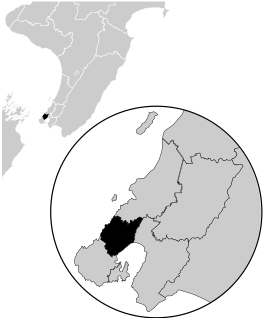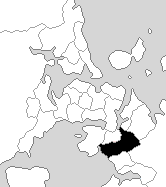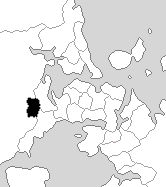
Pencarrow is a former Parliamentary electorate in the lower Hutt Valley of New Zealand, from 1978 to 1996.

Pencarrow is a former Parliamentary electorate in the lower Hutt Valley of New Zealand, from 1978 to 1996.
The 1977 electoral redistribution was the most overtly political since the Representation Commission had been established through an amendment to the Representation Act in 1886, initiated by Muldoon's National Government. [1] As part of the 1976 census, a large number of people failed to fill out an electoral re-registration card, and census staff had not been given the authority to insist on the card being completed. This had little practical effect for people on the general roll, but it transferred Māori to the general roll if the card was not handed in. Together with a northward shift of New Zealand's population, this resulted in five new electorates having to be created in the upper part of the North Island. [2] The electoral redistribution was very disruptive, and 22 electorates were abolished, while 27 electorates were newly created (including Pencarrow) or re-established. These changes came into effect for the 1978 election. [3]
The electorate is based on the southern part of the city of Lower Hutt.
Pencarrow existed from 1978, replacing the Petone electorate. In the 1978 election, the electorate was won by Fraser Colman, who had been MP for Petone since the 1967 by-election. [4] Colman retired in 1987 and was succeeded by Sonja Davies. [5] After her retirement in 1993, she was succeeded by Trevor Mallard. When the Pencarrow electorate was abolished in 1996, Mallard transferred to the Hutt South electorate. [6]
Key
| Election | Winner | |
|---|---|---|
| 1978 election | Fraser Colman | |
| 1981 election | ||
| 1984 election | ||
| 1987 election | Sonja Davies | |
| 1990 election | ||
| 1993 election | Trevor Mallard | |
| (Electorate abolished in 1996; see Hutt South) | ||
| Party | Candidate | Votes | % | ±% | |
|---|---|---|---|---|---|
| Labour | Trevor Mallard | 8,106 | 44.18 | ||
| National | Rosmarie Thomas | 5,546 | 30.23 | ||
| Alliance | Len Otway | 3,021 | 16.46 | ||
| NZ First | Kia Houpapa | 1,186 | 6.46 | ||
| Christian Heritage | Julian Paton | 380 | 2.07 | ||
| McGillicuddy Serious | Ben Cauchi | 186 | 1.01 | ||
| Majority | 2,641 | 14.39 | |||
| Turnout | 18,344 | 93.63 | +9.44 | ||
| Registered electors | 19,592 | ||||
| Party | Candidate | Votes | % | ±% | |
|---|---|---|---|---|---|
| Labour | Sonja Davies | 7,486 | 40.97 | +0.20 | |
| National | Ray Wallace | 7,102 | 38.87 | ||
| Green | K M Goldsmith | 1,499 | 8.20 | ||
| NewLabour | Ossie Renata | 1,199 | 6.56 | ||
| Independent Labour | Ian Greig | 374 | 2.04 | -17.93 | |
| Democrats | Peter Carter | 233 | 1.27 | -3.24 | |
| McGillicuddy Serious | J C McGruddy | 131 | 0.71 | ||
| NZ Party | M Millette | 125 | 0.68 | ||
| Social Credit | J E Cruickshank | 89 | 0.48 | ||
| People's Party | Christopher John Ellis | 25 | 0.13 | ||
| Communist League | Cecil Pirihi | 15 | 0.08 | ||
| Majority | 384 | 2.10 | -7.93 | ||
| Turnout | 18,270 | 84.19 | -2.10 | ||
| Registered electors | 21,700 | ||||
| Party | Candidate | Votes | % | ±% | |
|---|---|---|---|---|---|
| Labour | Sonja Davies | 7,524 | 40.77 | ||
| National | Andrew Harvey | 5,673 | 30.74 | ||
| Independent Labour | Ian Grieg | 3,686 | 19.97 | ||
| Democrats | Peter Carter | 834 | 4.51 | ||
| Independent Labour | P O Renata | 490 | 2.65 | ||
| Independent | S R O Dransfield | 126 | 0.68 | ||
| McGillicuddy Serious | John Morrison | 119 | 0.64 | ||
| Majority | 1,851 | 10.03 | |||
| Turnout | 18,452 | 86.29 | -5.61 | ||
| Registered electors | 21,383 | ||||
| Party | Candidate | Votes | % | ±% | |
|---|---|---|---|---|---|
| Labour | Fraser Colman | 10,338 | 54.65 | +0.87 | |
| National | Barry Cranston | 4,920 | 26.01 | ||
| NZ Party | Clive Wickens | 2,992 | 15.81 | ||
| Social Credit | P Lyth | 664 | 3.51 | ||
| Majority | 5,418 | 28.64 | +6.21 | ||
| Turnout | 18,914 | 91.90 | +2.36 | ||
| Registered electors | 20,580 | ||||
| Party | Candidate | Votes | % | ±% | |
|---|---|---|---|---|---|
| Labour | Fraser Colman | 9,745 | 53.78 | +0.39 | |
| National | Willard Amaru | 5,680 | 31.35 | ||
| Social Credit | Reg Moore | 2,692 | 14.85 | ||
| Majority | 4,065 | 22.43 | +2.49 | ||
| Turnout | 18,117 | 89.54 | +18.56 | ||
| Registered electors | 20,233 | ||||
| Party | Candidate | Votes | % | ±% | |
|---|---|---|---|---|---|
| Labour | Fraser Colman | 9,769 | 53.39 | ||
| National | Brett Newell | 6,030 | 32.95 | ||
| Social Credit | B E Reeves | 1,901 | 10.39 | ||
| Values | A B Gardiner | 596 | 3.25 | ||
| Majority | 3,649 | 19.94 | |||
| Turnout | 18,296 | 70.98 | |||
| Registered electors | 25,773 | ||||

The 1978 New Zealand general election was a nationwide vote to elect the 39th New Zealand Parliament. It saw the governing National Party, led by Robert Muldoon, retain office, but the opposition Labour Party won the largest share of the vote. Reorganisation of the enrolment system caused major problems with the electoral rolls, which left a legacy of unreliable information about voting levels in this election.
Albany was a New Zealand electorate. It was located in north Auckland, and named after the suburb of Albany. It existed from 1978 to 1984, and then was reinstated in 1987 before its final abolition in 2002.

Hutt South is a parliamentary electorate in the lower Hutt Valley of New Zealand. It is held by Ginny Andersen of the Labour Party following the 2020 election. It was previously held by Chris Bishop of the National Party Bishop's victory was the first time Hutt South has been held by a National Party MP since the electorate was created in 1996. Labour regained the electorate subsequently in the 2020 New Zealand general election.

Ōhāriu, previously spelled Ohariu and then Ōhariu, is a New Zealand parliamentary electorate returning one Member of Parliament to the House of Representatives. It first existed from 1978 to 1993, and was recreated for the 2008 election. In 2008, it was the successor to Ohariu-Belmont, first contested at the first mixed-member proportional (MMP) election in 1996. Through its existence Ohariu-Belmont was represented by Peter Dunne, leader of the United Future party. Dunne contested and won the recreated electorate in 2008. He announced on 21 August 2017, he would not be seeking re-election in the 2017 general election.

The Hunua electorate existed three times for the New Zealand House of Representatives beginning in 1978, based at the south end of the Auckland urban area, and named for the Hunua Ranges. It covered different geographical areas over those periods. The electorate was last represented by Andrew Bayly of the National Party before its dissolution in 2020.
Petone is a former parliamentary electorate in the lower Hutt Valley of New Zealand, from 1946 to 1978. The electorate was represented by two Members of Parliament from the Labour Party.
Rangiriri was a rural New Zealand parliamentary electorate in the Auckland Region from 1978 to 1984.
Kapiti was a New Zealand parliamentary electorate, from 1972 to 1996. A bellwether electorate, it frequently changed between National and Labour.
Horowhenua was a New Zealand parliamentary electorate, from 1978 to 1996.

Otara was a New Zealand parliamentary electorate in Auckland, from 1984 to 1996. It existed for four parliamentary terms and was represented by three members of parliament, two from Labour and one from National.
Fendalton is a former New Zealand parliamentary electorate. It existed during two periods between 1946 and 1996. The electorate was in the western suburbs of Christchurch, New Zealand. Fendalton is an expensive suburb, and was always represented by the National Party.
St Kilda is a former New Zealand parliamentary electorate. It existed from 1946 to 1996 and was represented by four Members of Parliament.

Eastern Hutt is a former New Zealand parliamentary electorate from 1978 to 1996. It was represented by two Labour MPs.

Western Hutt was a New Zealand parliamentary electorate from 1969 to 1996.
West Coast is a former New Zealand Parliamentary electorate, from 1972 to 1996.

Henderson is a former New Zealand parliamentary electorate, from 1969 to 1978 and then from 1993 to 1996.

Heretaunga is a former New Zealand parliamentary electorate, in the city of Upper Hutt, that existed from 1954 until 1996.
Yaldhurst is a former New Zealand parliamentary electorate, near the city of Christchurch. The electorate was to the southwest of Christchurch, and was suburban and semi-rural.

Papatoetoe is a former New Zealand parliamentary electorate, and is part of greater Auckland.
Hastings was a parliamentary electorate in the Hawke's Bay Region of New Zealand from 1946 to 1996. The electorate was represented by nine Members of Parliament. The Hastings electorate was a typical bellwether electorate, frequently changing between the two main parties.